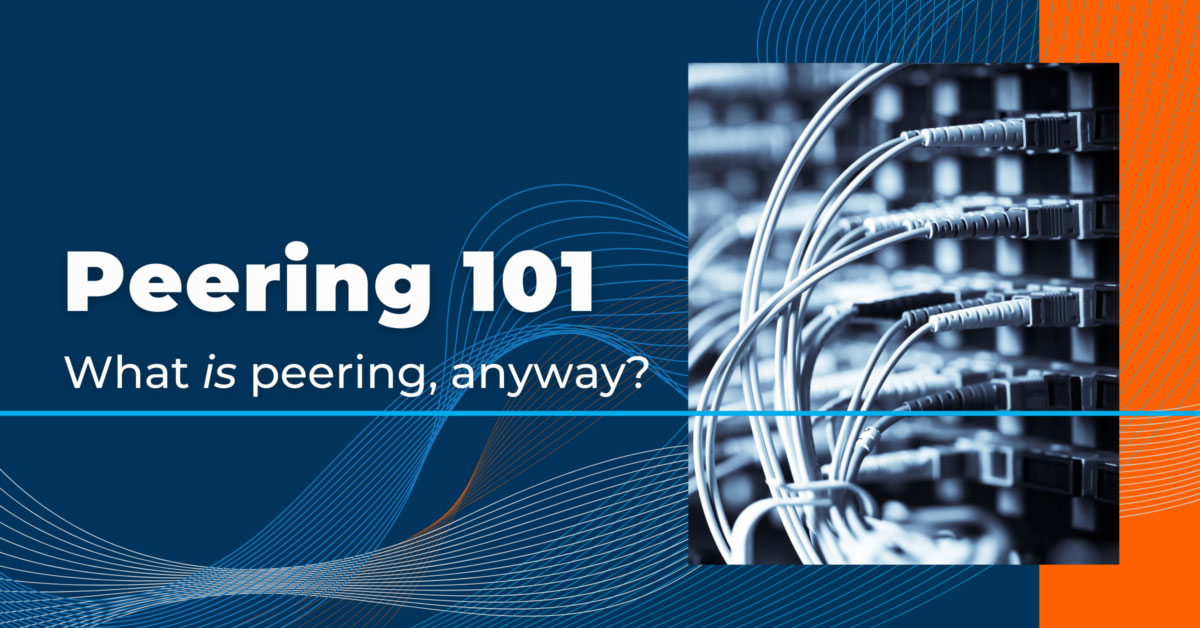Want to learn more about peering? Here’s a quick run down of the key aspects and benefits.
What is peering, anyway?
Sometimes called network peering or internet peering, peering at its most basic definition is when networks interconnect, allowing them to exchange traffic. At its core, it is about the transmitting and sharing of data.
With a typical internet connection – what’s called a transit connection – network operators (or end users) purchase the connection from someone else and pay to have their network traffic carried for them. In a peering setup, there are no third parties and no additional charges beyond the costs associated with powering the necessary routers and switches. One network connects to another straightaway, in a direct throughput. In this way, peering is also a business relationship between two or more networks to allow for the direct exchange of IP traffic in a mutually beneficial way.
Who is it for?
Peering can be utilized by a wide array of organizations. Internet service providers, content delivery networks, gaming providers, enterprises, universities, governments – anyone looking to quickly and easily exchange IP traffic can use peering.
Where did peering come from, and what is its future?
In the early 1980s, internet access centered around US government agencies. The birth of the first peering network occurred in 1991 – the commercial internet exchange in Virginia – in an attempt to connect computing networks without the use of complex contracts and administrative issues. Today, there are over 300 internet exchanges, including over 80 in the United States alone. Localized internet systems cover the globe to provide access to different regions, each with its own peering ecosystem. In places like Africa, interconnection through peering is building new economic realities by creating the opportunity for scalable local network infrastructures where there previously were none. In places like the United States, the revolution of edge computing environments – with their fast speeds, high throughputs, and low prices – are made possible through the advantages provided by peering.
How does it work?
The most important element is a physical location through which the direct exchange can occur – colocation facilities that deploy routers and transport equipment to create connectivity. This can be either through switches or direct fiber optic cables between individual suites or racks.
Sometimes a location establishes connectivity through individual network routers in a private peering – or Private Network Interconnect – arrangement. More common, however, is a public Internet Exchange Point (IXP). IXPs house the hardware necessary to connect multiple networks, where individual networks can establish Border Gateway Protocol (BGP) sessions with other participants. All that’s necessary is to apply for membership to gain colocation space, and the IXP will contact you to facilitate the connection. Then it’s just a matter of setting up an agreement to rent the space and manage your connection. Although public peering does not allow for visibility into other participants’ network utilization, it does mean one-to-many connectivity by allowing for many networks to connect to a common location.
There are a couple of other variants, too. One such alternative is partial (or regional) peering, where networks agree to exchange traffic only between certain users or customers instead of any and all customers. Another arrangement is called paid peering (or partial transit), where one network charges another to participate in the peering system with them, regardless of any other agreement either may have with the internet exchange.
What else is required for peering?
There are a few other technical requirements to be fulfilled. First, you’ll need a public Autonomous System number assigned by a Regional Internet Registry, along with (at least) a block of public IP addresses. Beyond that, a network looking to peer should make sure to have an edge router for the BGP protocol to configure the interconnections.
Now that you have a foundation of knowledge to build on, you can explore the many benefits of peering to determine if its right for you.
For robust peering options, check out Omaha-IX. It’s the premiere Midwest internet exchange location for connections from 1G to 100G.


